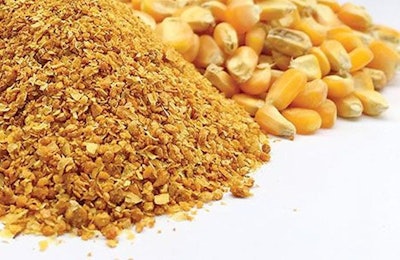
With a drop in availability of dried distillers grains with solubles, animal feed producers are returning to corn-soy diets
At the end of April, Texas Brent oil futures closed at nearly -US$37 per barrel, reaching almost -US$40 during the day. That is, you were getting paid US$37 to get a barrel of crude oil.
That was a classic case of oversupply and under-demand. The world oil trade war had caused an overflow of crude oil exceeding global storage capacity. At the same time, the novel coronavirus (COVID-19) pandemic lockdown markedly reduced oil consumption at a private, commercial and industrial level.
Bioethanol from corn distillation was just collateral damage. More than 50% of the U.S. bio-ethanol plants closed or are about to close because there is not much profit in this business anymore. Even if oil demand recovers, it is unlikely the oil war between the great powers to be will end anytime soon. Matters will become even more depressing if a second and third wave of the COVID-19 pandemic hits. There is also an optimistic scenario, but bioethanol is not likely to return in force any time soon, either way.
DDGS in animal feeds
Feed manufacturers and animal producers had become accustomed to using the byproduct of bioethanol production, not only in the U.S. but also worldwide. The DDGS (dried distillers grains with solubles) are an inexpensive source of protein, oil and fiber. If one considers it carefully, DDGS is just corn minus starch times three. That is, protein, oil, ash and fiber concentrations are about three times higher in DDGS than in corn. The same is true for pigments (xanthophylls) and any contaminants, such as mycotoxins.
The inclusion rate of DDGS in diets for monogastric animals, such as poultry and pigs, ranged from 5% to 30% depending on age and condition. In ruminants, DDGS figured rather high in beef rations and not so high in those for dairy cows, but consumption was equally high due to volume. Thus, a big gap in nutrients is going to appear as DDGS supply dries up, and this is going to have as much a local as a global impact because much of DDGS production is locally concentrated. Luckily, U.S. farmers have an excellent alternative – soybean meal – which may be a bit more expensive today, but its price is likely to drop as exports are not as forthcoming as predicted (another trade war here is affecting the global soy trade).
Replacing DDGS with soybean meal
So, to replace DDGS with soybean meal – or to go back to the traditional U.S. corn-soy formulas – the following example may serve as a discussion point. I used my Allix3 formulation program (A-Systems) and formulated two identical late-finishing pig feeds. One was formulated to contain only DDGS (9018A in the downloadable raw datasheet), the other only with soybean meal (9018B). The diets were balanced with the usual suspects such as feed-grade amino acids, minerals, and a common energy-bearing source such as white grease. Here are some interesting findings (disregarding costs and prices):
- The same diet with about 15% protein and 0.7% digestible lysine required only 19% soybean meal to 30% DDGS. The soy-only diet required less lysine and threonine supplementation, and none of tryptophan. Soybean meal is a known rich source of these amino acids. Methionine supplementation did not differ.
- In contrast, the soy diet required extra phosphorus supplementation compared with none added in the DDGS diet. This can affect the usage of the enzyme phytase. The adjustments in calcium and sodium are insignificant due to their very low sourcing cost.
- The soy diet required a bit of extra energy, but the amount of added grease is less than what many feed mills can handle with accuracy, and a real-case formula may differ as energy values of DDGS tend to vary considerably.
In terms of formulation adjustments, the only real differences are the reductions in feed-grade amino acids and an adjustment in phosphorus. This will certainly impact the profit line of these industries.
Other considerations are to be made as well, which may merit more or less attention:
- As DDGS are removed or reduced from a diet, the mycotoxin load may (or not) diminish or its profile may (or not) change. So, an adjustment in the use (or not) of an anti-mycotoxin agent is warranted.
- In diets for layers, a reduction in egg yolk pigmentation will be observed with less DDGS, but this can be easily remedied with the addition of natural or synthetic pigments.
- Carcass fat will tend to be less yellow in soy-fed animals, but not much firmer as both ingredients in question are rich in polyunsaturated fatty acids.
- Animals on soy-based diets may increase their feed intake as they appear to prefer the “beany” taste of soybeans. This may require an adjustment in feed specifications.
- Isoflavones and other bioactive compounds in soybeans have been recently shown to have an uplifting effect on animal health and consequently overall performance.
And a final word of caution: Although U.S. soybean meal is well known for its quality, just like every other byproduct, quality is not given but rather controlled and assured. So, switching from a quality source of DDGS to an unknown source of low-quality soybean meal may cause depression of animal performance. A qualified nutritionist will be able to test soybean meal for its quality and direct it to the proper animal feed if it is of less-than-ideal standard.
View our continuing coverage of the novel coronavirus (COVID-19) pandemic.











